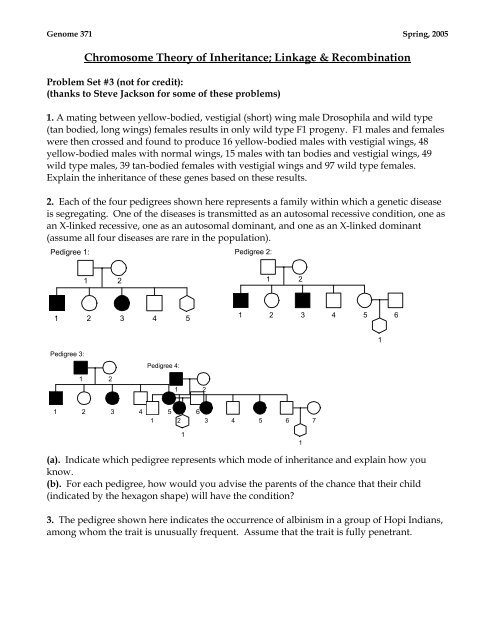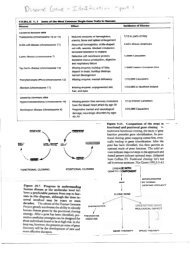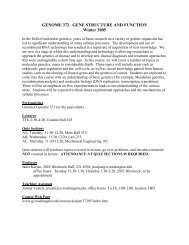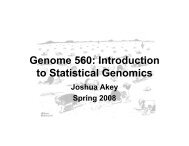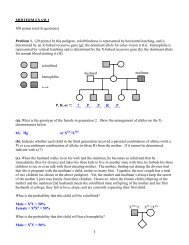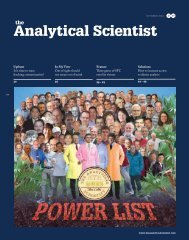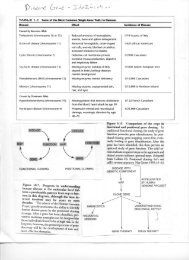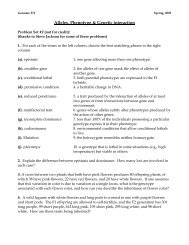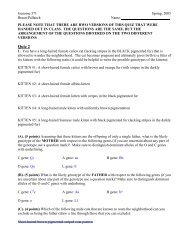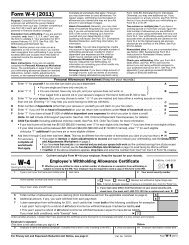Create successful ePaper yourself
Turn your PDF publications into a flip-book with our unique Google optimized e-Paper software.
Genome 371 Spring, 2005<br />
Chromosome Theory of Inheritance; Linkage & Recombination<br />
<strong>Problem</strong> <strong>Set</strong> #3 (not for credit):<br />
(thanks to Steve Jackson for some of these problems)<br />
1. A mating between yellow-bodied, vestigial (short) wing male Drosophila and wild type<br />
(tan bodied, long wings) females results in only wild type F1 progeny. F1 males and females<br />
were then crossed and found to produce 16 yellow-bodied males with vestigial wings, 48<br />
yellow-bodied males with normal wings, 15 males with tan bodies and vestigial wings, 49<br />
wild type males, 39 tan-bodied females with vestigial wings and 97 wild type females.<br />
Explain the inheritance of these genes based on these results.<br />
2. Each of the four pedigrees shown here represents a family within which a genetic disease<br />
is segregating. One of the diseases is transmitted as an autosomal recessive condition, one as<br />
an X-linked recessive, one as an autosomal dominant, and one as an X-linked dominant<br />
(assume all four diseases are rare in the population).<br />
Pedigree 1:<br />
Pedigree 2:<br />
1 2<br />
1 2<br />
1 2 3 4<br />
5<br />
1 2 3 4<br />
5 6<br />
1<br />
Pedigree 3:<br />
Pedigree 4:<br />
1 2<br />
1 2<br />
1 2 3 4<br />
5 6<br />
1 2 3 4<br />
5 6<br />
7<br />
1<br />
1<br />
(a). Indicate which pedigree represents which mode of inheritance and explain how you<br />
know.<br />
(b). For each pedigree, how would you advise the parents of the chance that their child<br />
(indicated by the hexagon shape) will have the condition?<br />
3. The pedigree shown here indicates the occurrence of albinism in a group of Hopi Indians,<br />
among whom the trait is unusually frequent. Assume that the trait is fully penetrant.
Genome 371 Spring, 2005<br />
I<br />
1 2<br />
3 4 5 6 7 8 9<br />
II<br />
1 2 3 4 5 6<br />
7<br />
8 9<br />
III<br />
IV<br />
1<br />
2 3 4 5 6 7<br />
(a). Is albinism in this population caused by a recessive or dominant allele?<br />
(b). Is the gene sex-linked or autosomal?<br />
(c). What are the genotypes of the following individuals:<br />
Individual I-1 Individual I-8 Individual I-9<br />
Individual II-6 Individual II-8 Individual III-4<br />
4. The following is a pedigree of a family in which a rare form of colorblindness is found.<br />
Indicate as much as you can about the genotypes of all the individuals in the pedigree.<br />
1<br />
I<br />
1<br />
2<br />
II<br />
1 2 3 4<br />
III<br />
1<br />
2 3 4<br />
5. Several different antigens can be detected in blood tests. The following four traits were<br />
tested for each individual shown below.<br />
ABO type: [I A and I B codominant, i recessive]<br />
Rh type: [Rh + dominant to Rh - ]<br />
MN type: [M and N codominant]<br />
Xg(a) type: [X g(a+) dominant to X g(a-) ]<br />
All of these blood type genes are autosomal, except for Xg(a) which is X-linked.<br />
Mother: AB Rh - MN X g(a+)<br />
Daughter: A Rh + MN X g(a-)<br />
Alleged father 1: AB Rh + M X g(a+)<br />
Alleged father 2: A Rh - N X g(a-)<br />
Alleged father 3: B Rh + N X g(a-)
Genome 371 Spring, 2005<br />
Alleged father 4: O Rh - MN X g(a-)<br />
(a). Which, if any, of the alleged fathers could be the real father?<br />
(b). Would your answer to part (a) change if the daughter had Turner syndrome (XO<br />
female)? If so, how?<br />
6. Hemophilia and red-green colorblindness are both X-linked recessive traits in humans.<br />
(X h = hemophilia allele, X H is normal; X g = colorblindness allele, X G = normal). A couple<br />
have had a hemophilic son with Klinefelter syndrome (XXY male). They would like to have<br />
a second child, but are worried about the risk of hemophilia. Their genetic counselor (who<br />
knows both their genotypes with respect to hemophilia) tells them that there is a 50% chance<br />
that their next child will have hemophilia regardless of whether it is a son or daughter<br />
(assuming that the child is normal).<br />
(a). What combinations of egg and sperm genotypes (with respect to the sex chromosome<br />
and hemophilia allele) could have given rise to the XXY son?<br />
(b). What are the genotypes of the parents with respect to hemophilia? Explain how you<br />
know this.<br />
(c). The woman is red-green colorblind, while the man and son have normal vision.<br />
Diagram the meiosis where the nondisjunction gave rise to the aberrant (defective) gamete.<br />
Mark the genotypes on the chromosomes. Show the chromosomes and chromatids at the<br />
start of meiosis, at the end of meiosis I, and at the end of meiosis II. Use long lines for the X<br />
chromosome and short lines for the Y chromosome.<br />
7. Consider the following pedigree of a rare form of testicular cancer. Assume the allele<br />
responsible for the disease is completely penetrant.<br />
(a). Is the gene responsible for the disease autosomal or sex-linked? Why?<br />
(b). Would your answer change if the mutation responsible for the cancer is common?<br />
Explain.<br />
8. Choose the phrase from the right column that best fits the term in the left column.<br />
(a). recombination<br />
(b). linkage<br />
1. A statistical method for testing the fit between observed<br />
and expected results.<br />
2. An ascus containing spores of four different genotypes.
Genome 371 Spring, 2005<br />
(c). chi square test<br />
(d). chiasma<br />
(e). tetratype<br />
(f). locus<br />
(g). coefficient of<br />
coincidence<br />
(h). interference<br />
(i). Parental ditype<br />
(j). ascospores<br />
(k). First division<br />
segregation<br />
3. One crossover along a chromosome makes a second<br />
nearby crossover less likely.<br />
4. When two loci recombine in less than 50% of gametes.<br />
5. The relative chromosomal location of a gene.<br />
6. The ratio of observed double crossovers to expected<br />
double crossovers.<br />
7. Fungal spores contained in a sac.<br />
8. Formation of new genetic combinations by exchange of<br />
parts between homologs.<br />
9. When the two alleles of a gene are segregated into<br />
different cells at the first meiotic division.<br />
10. An asci containing only two nonrecombinant kinds of<br />
spores.<br />
11. Structure formed at the spot where crossing over<br />
occurs between homologs.<br />
9. Two genes on chromosome 7 of corn are identified by the recessive alleles gl (glossy),<br />
which determines glossy leaves, and ra (ramosa), which determines branching of ears. When<br />
a plant heterozygous for each of these alleles was crossed with a homozygous recessive plant,<br />
the progeny consisted of the following genotypes:<br />
Gl ra 88 gl Ra 103<br />
Gl Ra 6 gl ra 3<br />
What is the frequency of recombination between these genes?<br />
10. In the yellow fever mosquito Aedes aegypti, a dominant gene DDT, for DDT resistance and<br />
a dominant gene Dl for Dieldrin resistance (Dieldrin is another long-lasting insecticide) are<br />
known to be on the same chromosome. A cross was carried out between a DDT-resistant<br />
strain and a Dieldrin-resistant strain, and dihybrids resistant to both insecticides were<br />
testcrossed with wildtype males. The progeny observed were: 88 resistant to DDT only, 89<br />
resistant to Dieldrin only, 98 sensitive to both insecticides, and 107 resistant to both<br />
insecticides.<br />
(a). Are these genes linked or unlinked?<br />
(b). A χ 2 test for linkage is to test whether the parental and recombinant classes are present<br />
in a 1:1 ratio. Test your hypothesis about whether or not the genes are linked with χ 2 test.<br />
(c). What can you say about the relative location of these genes on the chromosome?<br />
11. In the tomato, tall is dominant to dwarf, smooth-skinned fruit is dominant to fuzzyskinned<br />
fruit, and round fruit is dominant to oblate (pear) shaped. All of the dominant alleles
Genome 371 Spring, 2005<br />
represent the wild type condition. A trihybrid of unknown origin is testcrossed to a dwarf,<br />
fuzzy, oblate tomato and the following progeny are observed:<br />
tall, smooth, oblate, 151<br />
tall, smooth, round 33<br />
tall, fuzzy, round 11<br />
tall, fuzzy, oblate 2<br />
dwarf, fuzzy, round 155<br />
dwarf, fuzzy, oblate 29<br />
dwarf, smooth, oblate 12<br />
dwarf, smooth, round 0<br />
(a). What is the allele configuration of the parent?<br />
(b). Draw a genetic map depicting these loci with map distances labeled.<br />
(c). Was interference observed in this cross? Show your work.<br />
12. That farmer in the Skagit Valley just won't shut up about his tulips. He tells you of other<br />
varieties of tulips he's found. One is short-stemmed, and examination of monohybrids<br />
suggests it is recessive to normal-stemmed. Another trait is red; to him, this is a mystery<br />
because when red tulips are crossed to white, all the progeny are pink, but when the pinks<br />
are selfed, they produce red, white and pink progeny. He wishes to map these traits with<br />
respect to each other and to his fringed petaled-plants (remember, recessive to normalshaped),<br />
so he can plant efficiently for marketing hybrid varieties. He has a short, white,<br />
fringed true-breeding stock, and a red true-breeding stock of normal height and petal shape.<br />
(a). What is the first cross you tell him to do?<br />
(b). He does it, testcrosses the trihybrid to short, white, fringed plants, and obtains the<br />
following results<br />
Short, white, fringed 623<br />
Short, pink, fringed 2<br />
Short, white 62<br />
Short, pink 29<br />
White, fringed 25<br />
White 3<br />
Pink, fringed 63<br />
Pink 630<br />
Draw a genetic map of these loci, including map distances, gene order, and any interference.<br />
(c). The farmer wants to establish a true-breeding stock of his short, pink, fringed plants.<br />
Can he do it? How, or why not?<br />
13. The following is a genetic map of a region of a chromosome:<br />
gene a -10cM- gene b - 5cM- gene c -20cM- gene d
Genome 371 Spring, 2005<br />
Start with a heterozygote with all the mutant alleles of these genes in cis, perform a testcross with<br />
this tetrahybrid as one of the parents, and examine 10,000 progeny:<br />
(a). How many progeny do you expect to have the phenotype a + + +?<br />
(b). How many will have the phenotype a b + +?<br />
(c). How many will have the phenotype a + c +?<br />
14. If the a and b loci are 20 map units apart in humans, and an AB/ab woman marries an ab/ab<br />
man, what is the probability that their first child will be Ab/ab?<br />
15. A tomato farmer wants to grow and sell fuzzy, yellow, beaked (pear-shaped) tomatoes. Each of<br />
these traits is determined by a single recessive gene (fz, y and bk, respectively). Although he has a<br />
true-breeding stock containing all these mutations, it is very unhealthy and not practical for<br />
growing lots of tomatoes. He therefore wants to construct a new stock. He knows that beaked and<br />
fuzzy are normally 38 map units apart in normal tomato plants, and he knows that yellow is normally<br />
unlinked to these genes. He plans to cross bk fz / bk fz plants to y / y plants, cross the trihybrid to his<br />
sick testcross stock, and isolate the resulting bk fz y recombinant plants.<br />
(a). When he does this, what percentage of the progeny will be fuzzy, yellow and beaked? Do not<br />
ignore recombination between bk and fz.<br />
(b). The farmer also knows that as a result of the Tomato Genome Project, variants have been<br />
isolated in which the yellow locus is now linked to both fuzzy and beaked. Furthermore, a map of<br />
these variants has been determined: beaked -38cM- fuzzy -18cM -yellow. His alternate plan is to<br />
obtain the + + yellow variants from the Project and cross them to the corresponding bk fz + variants.<br />
He will then testcross this trihybrid, and isolate the resulting bk fz y recombinant plants. Using this<br />
approach, what percentage of the progeny will be fuzzy, yellow and beaked? Assume all the<br />
chromosomes used for this have the same translocation, and again, do not ignore recombination<br />
between bk and fz.<br />
(c). What do you think is therefore the most economical way for the farmer to obtain the<br />
plants he wants?<br />
16. A cross was performed between a yeast strain that requires methionine and lysine for<br />
growth (met - , lys - ) and another yeast strain which is met + lys + . One hundred asci were<br />
dissected and colonies were grown for the four spores in each ascus. Cells from these<br />
colonies were tested for their ability to grow on Petri plates containing either minimal<br />
medium (min), min + lysine (lys), min + methionine (met), or min + lys + met. The asci could<br />
be divided into two groups based on this analysis:<br />
Group 1: In 89 asci, cells from two of the four spore colonies could grow on all four<br />
kinds of media, while the other two spore colonies could only grow on min + lys + met.<br />
Group 2: In 11 asci, cells from one of the four spore colonies could grow on all four<br />
kinds of petri plates. Cells from a second one of the four spore colonies could grow only on<br />
min + lys plates and on min + lys + met plates. Cells from a third of the four spore colonies<br />
could only grow on min + met plates and on min + lys + met plates. Cells from the<br />
remaining colony could only grow on min + lys + met.<br />
(a). What are the genotypes of the spores within each of the two types of asci?<br />
(b). Are the lys and met genes linked? If so, what is the map distance between them?
Genome 371 Spring, 2005<br />
(c). If you could extend this analysis to many more asci, you would eventually find some asci<br />
with a different pattern. For these asci, describe the phenotypes of the four spores. List this<br />
as the ability of dissected spores to form colonies on the four kinds of petri plates.<br />
17. A single yeast cell placed on a solid agar will divide mitotically to produce a colony of<br />
about 10 7 cells. A haploid yeast cell that has a mutation in the ade2 gene will produce a red<br />
colony; an ade2 + colony will be white. Some of the colonies from a diploid yeast cell with a<br />
genotytpe of ade2 + /ade2 - will contain sectors of red within a white colony. How would you<br />
explain these sectors?<br />
18. One form of hemophilia, an X-linked disorder of blood clotting, is caused by mutation in<br />
clotting factor VIII. Many single-nucleotide mutations of this gene have been described,<br />
making detection of mutant genes by Southern blots inefficient. There is, however, an RFLP<br />
for the enzyme HindIII contained in an intron of the factor VIII gene that can often be used in<br />
screening, as shown below.<br />
hindIII hindIII hindIII<br />
hindIII hindIII<br />
region<br />
detected 1'-6"<br />
by probe<br />
region<br />
detected 1'-6"<br />
by probe<br />
4kb<br />
3kb<br />
A female whose brother has hemophilia is at 50% risk of being a carrier of this disorder. To<br />
test her status, DNA is obtained from white blood cells from family members, cut with<br />
HindIII, and the fragments probed and visualized by Southern blotting. The results are<br />
shown below (the mothers symbol represents a probable carrier):
Genome 371 Spring, 2005<br />
? ?<br />
= carrier of sex-linked recessive mutation.<br />
Determine whether any of the females in generation II are carriers for hemophilia.<br />
19. A man heterozygous for a disease gene D is also heterozygous for an RFLP linked at a<br />
distance of 6 map units from the disease gene. His chromosomal arrangement is D RFLP-1/d<br />
RFLP-2 (where d represents the wild type allele of the disease gene). What percentage of his<br />
sperm will be D RFLP-2?<br />
20. A woman heterozygous for a dominant disease gene D is also heterozygous for an RFLP<br />
linked 10 map units away. The chromosomal arrangement is D RFLP-1/d RFLP-2. Her<br />
unaffected mate is homozygous for RFLP-2. Her fetus is tested and is shown to be<br />
homozygous for RFLP-2. What is the probability that the child will have the disease?<br />
21. A gene for a genetic disease in cats (D) is linked to an RFLP. A female from a pure-bred<br />
strain of cats (a pure-bred strain of cats means that the cats are homozygous at every locus,<br />
ideally) unaffected by the disease is crossed to a male from a pure bred strain affected by the<br />
disease. The F 1 were intercrossed to produce an F 2 that included 8 kittens, as shown in the<br />
pedigree below:
Genome 371 Spring, 2005<br />
I<br />
1 2<br />
II<br />
3 4<br />
III<br />
7kb<br />
4kb<br />
5 6 7 8 9 10 11 12<br />
(a). Assuming the disease is fully penetrant, does the disease appear to be dominant or<br />
recessive?<br />
(b). What is the genotype of the II-3 individual?<br />
22. A pedigree is shown below involving seven different alleles at an RFLP locus. The<br />
autoradiogram of an electrophoretic gel shows the distinctive positions of eight fragments (1-<br />
8) from the individuals shown in the pedigrees:<br />
I<br />
1 2<br />
3 4<br />
II<br />
III<br />
1<br />
2<br />
3<br />
4<br />
5<br />
6<br />
7<br />
8<br />
1 2<br />
1 2 3 4 5 6 7<br />
(a). Which alleles should each of the parents (II-1 and II-2) have on the basis of the<br />
grandparents' and children's genotypes?<br />
(b). If individuals III-1 and III-3 have children together, what combinations of alleles would<br />
be observed in their offspring?
Genome 371 Spring, 2005<br />
23. Filled symbols in the pedigree indicate people with a rare autosomal dominant genetic<br />
disease. DNA samples were prepared from each of the individuals in the pedigree. The<br />
samples were digested with a restriction endonuclease and analyzed by Southern blot<br />
analysis using a probe corresponding to a human sequence called DS12-88, with the results<br />
shown in the figure below. Do the data in these two figures support the hypothesis that the<br />
gene for the disease that is segregating in this family is linked to the region homologous to<br />
DS12-88?<br />
generation:<br />
I<br />
1 2<br />
II<br />
1 2<br />
3 4 5 6<br />
III<br />
1 2 3 4 5 6<br />
7 8 9 10 11 12 13 14<br />
IV<br />
1 2 3 4 5 6<br />
7<br />
I II III IV<br />
1 2 1 2 3 4 5 6 1 2 3 4 5 6 7 8 9 10 11 12 13 14 1 2 3 4 5 6 7


